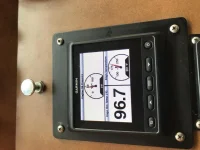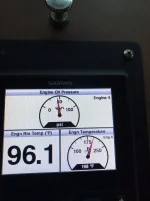MVCaprice
Well-known member
- Joined
- Aug 16, 2012
- Messages
- 663
- Status
- OWNER - I own a Hatteras Yacht
- Hatteras Model
- 61' MOTOR YACHT (1980 - 1985)
Does anyone have guage info/curves for the dual station AC Delco gauges/senders? I have been working with ActiSense on getting support for our gauges and need a few more pieces of info.
I previously cataloged the following on my (12v) gauges:
Water Temp 100-220 Degrees F
Duel Station Guage
AC Delco Part Number 8993271
Ground to Postive Resistance in Ohms 201.3
Positive to Sender Resistance in Ohms 47.7
Ground to Sender Resistance in Ohms 248.8
Drive oil Pressure 0-400PSI
AC Delco Part Number 25025326
Ground to Postive Resistance in Ohms 191.1
Positive to Sender Resistance in Ohms 118.7
Ground to Sender Resistance in Ohms 75
Oil Pressure 0-80PSI
Duel Station Guage
AC Delco Part 5626324
Ground to Postive Resistance in Ohms 217.2
Positive to Sender Resistance in Ohms 118.5
Ground to Sender Resistance in Ohms 98.9
Below are the data points that ActiSense is asking me for currently. I have only completed step one unfortunately.
Procedure for manually measuring a gauge
[FONT=Calibri,Calibri][FONT=Calibri,Calibri]Equipment required: A Multimeter with Voltage, Current and Resistance measurement.
The test consists of 2 steps, the first step measures the gauge when it is completely disconnected from everything. The second step measures the gauge when it is connected to its normal power supply on the boat.
[/FONT][/FONT]Step 1
[FONT=Calibri,Calibri][FONT=Calibri,Calibri]Disconnect the gauge from everything. The gauge should have 3 terminals:
1. + terminal (The supply voltage terminal)
2. – terminal (The ground terminal)
3. S terminal (The Signal terminal which connects to the Sender)
Test 1, Using the multimeter set to ‘Resistance’ measurement mode
1. Measure and record the resistance between the + terminal and the – terminal.
2. Measure and record the resistance between the S terminal and the – terminal.
3. Measure and record the resistance between the S terminal and the + terminal.
[/FONT][/FONT]Step 2
[FONT=Calibri,Calibri][FONT=Calibri,Calibri]Now connect the gauge to its normal power supply. Connect the – terminal to ground and the + terminal to the normal supply voltage, NB - leave the S terminal unconnected, it must not be connected to the sender!
Test 2, using the multimeter set to ‘Voltage’ measurement mode
1. Note down whether the gauge needle deflects to full scale or whether it stays at zero.
2. Measure and record the exact supply voltage between the + and - gauge terminals.
3. Measure and record the exact voltage between the S and – gauge terminals.
4. Start the motor and let it idle, again measure and record the exact supply voltage between the + and - gauge terminals.
5. Start the motor and let it idle, again measure and record the exact voltage between the S and – gauge terminals.
Test 3, using the multimeter set to ‘Current’ measurement mode (leads inserted into current measurement terminals on multimeter)
1. Measure and record the current between the S and – gauge terminals. (Red lead connected to S terminal, Black lead connected to – terminal)
2. Note down whether the gauge needle deflects to full scale or whether it stays at zero.
[/FONT][/FONT]
I previously cataloged the following on my (12v) gauges:
Water Temp 100-220 Degrees F
Duel Station Guage
AC Delco Part Number 8993271
Ground to Postive Resistance in Ohms 201.3
Positive to Sender Resistance in Ohms 47.7
Ground to Sender Resistance in Ohms 248.8
Drive oil Pressure 0-400PSI
AC Delco Part Number 25025326
Ground to Postive Resistance in Ohms 191.1
Positive to Sender Resistance in Ohms 118.7
Ground to Sender Resistance in Ohms 75
Oil Pressure 0-80PSI
Duel Station Guage
AC Delco Part 5626324
Ground to Postive Resistance in Ohms 217.2
Positive to Sender Resistance in Ohms 118.5
Ground to Sender Resistance in Ohms 98.9
Below are the data points that ActiSense is asking me for currently. I have only completed step one unfortunately.
Procedure for manually measuring a gauge
[FONT=Calibri,Calibri][FONT=Calibri,Calibri]Equipment required: A Multimeter with Voltage, Current and Resistance measurement.
The test consists of 2 steps, the first step measures the gauge when it is completely disconnected from everything. The second step measures the gauge when it is connected to its normal power supply on the boat.
[/FONT][/FONT]Step 1
[FONT=Calibri,Calibri][FONT=Calibri,Calibri]Disconnect the gauge from everything. The gauge should have 3 terminals:
1. + terminal (The supply voltage terminal)
2. – terminal (The ground terminal)
3. S terminal (The Signal terminal which connects to the Sender)
Test 1, Using the multimeter set to ‘Resistance’ measurement mode
1. Measure and record the resistance between the + terminal and the – terminal.
2. Measure and record the resistance between the S terminal and the – terminal.
3. Measure and record the resistance between the S terminal and the + terminal.
[/FONT][/FONT]Step 2
[FONT=Calibri,Calibri][FONT=Calibri,Calibri]Now connect the gauge to its normal power supply. Connect the – terminal to ground and the + terminal to the normal supply voltage, NB - leave the S terminal unconnected, it must not be connected to the sender!
Test 2, using the multimeter set to ‘Voltage’ measurement mode
1. Note down whether the gauge needle deflects to full scale or whether it stays at zero.
2. Measure and record the exact supply voltage between the + and - gauge terminals.
3. Measure and record the exact voltage between the S and – gauge terminals.
4. Start the motor and let it idle, again measure and record the exact supply voltage between the + and - gauge terminals.
5. Start the motor and let it idle, again measure and record the exact voltage between the S and – gauge terminals.
Test 3, using the multimeter set to ‘Current’ measurement mode (leads inserted into current measurement terminals on multimeter)
1. Measure and record the current between the S and – gauge terminals. (Red lead connected to S terminal, Black lead connected to – terminal)
2. Note down whether the gauge needle deflects to full scale or whether it stays at zero.
[/FONT][/FONT]



